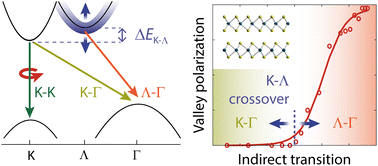Impact of indirect transitions on valley polarization in WS2 and WSe2†
Abstract
Controlling the momentum of carriers in semiconductors, known as valley polarization, is a new resource for optoelectronics and information technologies. Materials exhibiting high polarization are needed for valley-based devices. Few-layer WS2 shows a remarkable spin-valley polarization above 90%, even at room temperature. In stark contrast, polarization is absent for few-layer WSe2 despite the expected material similarities. Here, we explain the origin of valley polarization in both materials based on the interplay between two indirect optical transitions. We show that the relative energy minima at the Λ- and K-valleys in the conduction band determine the spin-valley polarization of the direct K–K transition. Polarization appears as the energy of the K-valley rises above the Λ-valley as a function of temperature and number of layers. Our results advance the understanding of the high spin-valley polarization in WS2. This insight will impact the design of both passive and tunable valleytronic devices operating at room temperature.

- This article is part of the themed collection: Nanoscale quantum technologies


 Please wait while we load your content...
Please wait while we load your content...